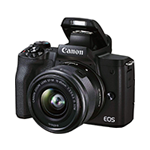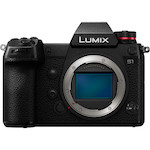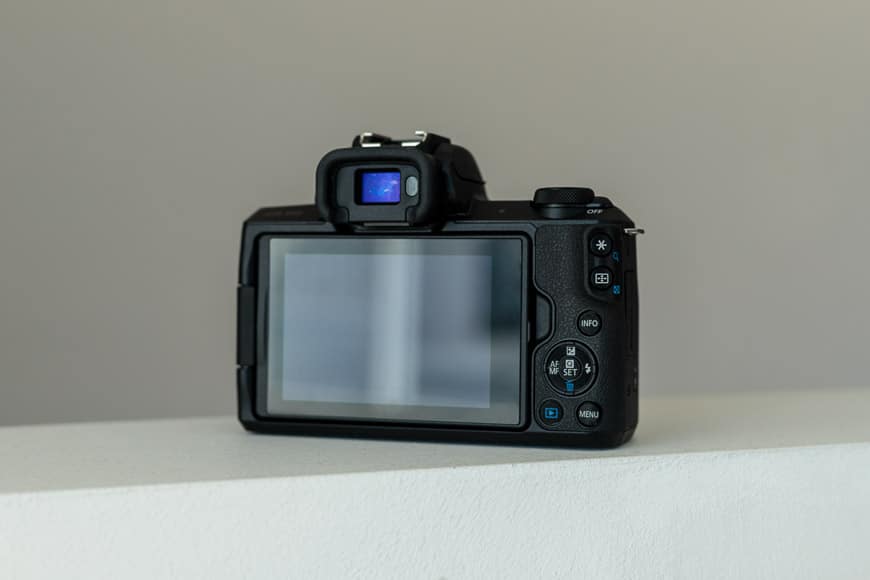
7 Best Touch Screen Cameras of 2023 (Tap Functionality)
Looking for a camera with a fully functional touch screen? They're not as easy to find as you might think. Here are our top picks of the year so far.
Buying a camera with a touch screen is a logical progression if you use your smartphone to take photos.
Intuitive actions like pinch to zoom, swipe to skip and touch to focus can be useful on digital camera screens too.
While most modern mirrorless cameras and compact cameras have touchscreens, they are usually limited to just a few functions.

Excellent image quality and dynamic range with impressive in-body stabilization, great battery life and a responsive touchscreen.
In this expert’s guide, I’ve chosen the best touchscreen cameras with all the most useful features you’d find on your iPhone, plus a few more.
Fortunately, all the models featured below also offer great image quality too.
Let’s take a look at which touchscreen cameras are worth your money this year.
Table of Contents
What are the Best Touch Screen Cameras in 2023?
| Image | Product | Features | |
|---|---|---|---|
 | Nikon Z7 IIBEST MIRRORLESS |
| Check AMAZON Price → Check B&H Price → |
 | Canon EOS 5D Mark IV BEST DSLR |
| Check AMAZON Price → Check B&H Price → |
 | Hasselblad X1D II 50CBEST MIRRORLESS MEDIUM FORMAT |
| Check AMAZON Price → Check B&H Price → |
 | Sony A6600BEST COMPACT |
| Check AMAZON Price → Check B&H Price → |
 | Canon EOS M50 Mark IIBEST BUDGET |
| Check AMAZON Price → Check B&H Price → |
 | Sony A7 IVBEST BATTERY LIFE |
| Check AMAZON Price → Check B&H Price → |
 | Panasonic Lumix S1BEST HYBRID |
| Check AMAZON Price → Check B&H Price → |
Nikon Z7 II (Best Mirrorless Touch Screen Camera)
- Well-built
- Dual card slot
- Weather sealed
- Tilt-enabled responsive touchscreen
- Excellent image stabilization
- EVF is lagging behind the competition
- Autofocus tracking needs improvement
The Nikon Z7 II is a great all-round mirrorless touchscreen digital camera.
It’s rugged, weather-sealed, with fantastic handling and an intuitive layout that allows you to customize some of the function buttons.
It has an excellent, 46-megapixel sensor, which can bring you down to a native ISO64, so you have great dynamic range and low-light performance.
The Nikon Z7 II has improved autofocus on the previous version, which is welcome, and the eye tracking is especially good, although in general autofocus tracking is still not as good as it could be.
The camera does have excellent in-body stabilization, and the specs to shoot 4K 60fps with a very minor crop, so it’s good for video.

Nikon Z7 II + Nikkor Z 24-70mm f/2.8 S, 8s, f/3.5, ISO 1600 | Matte Hanna
The 3.2-inch, 2.1m-dot LCD screen is very sharp and easy to use. You can use it for Live View shooting, image playback, plus menu navigation and settings control.
It tilts vertically, too, to help you shoot from high and low angles.
Canon EOS 5D Mark IV (Best DSLR Touch Screen Camera)
- Great image quality
- User-friendly
- Excellent design and build
- Responsive touchscreen
- 4K video crops
- Touch-screen doesn’t articulate
This is a much-loved full-frame workhorse for pro photographers who also want to shoot video. And, it was the first Canon DSLR digital camera to integrate touchscreen technology.
Its 30-megapixel CMOS sensor gives you a good dynamic range and the sharp, warm and life-like colours Canon are well-known for.
Video is also an option, at 4K up to 30fps, although it does come with a 1.6x crop.
The Canon 5D Mark IV has a 3.2-inch, 1.62m-dot Clear View II LCD screen with an anti-reflective design for shooting even in bright light.
As well as image playback and Live View shooting, the touchscreen interface can be used for intuitive touch-to-focus autofocus control and to adjust settings in the menus.

5D Mark IV + Canon 35mm F/1.4L II | 1/1250 f/1.4 ISO100 | Jay Cassario
There are also quick access buttons on the touchscreen, which means you don’t have to scroll through pages of menu options.
Although the screen doesn’t tilt, with the responsive touch-autofocus it still gives you the ability to compose sharp photos from awkward angles you wouldn’t be able to use the viewfinder from.
Hasselblad X1D II 50C (Best Mirrorless Medium Format Touch Screen Camera)
- Beautiful
- Compact camera
- Solid image quality
- Huge sensor
- Autofocus isn’t great
- No video
- Low continuous shooting speed
Ah Hasselblad, the most legendary of cameras.
And this is a beautiful medium format mirrorless digital camera. It’s well-designed and comfortable to hold with its ergonomic grip.
Plus it has a 50-megapixel sensor, so as well as your images having that Hasselblad feel, you have a great dynamic range to play with.

Hasselblad X1D II 50C Sample Images | Rick Birt
This new version has an improved viewfinder and battery life. The new touchscreen doesn’t have the lag that it used to.
And the touchscreen is large. A 3.6-inch, 2.36m-dot LCD for intuitive control, menu navigation, and playback.
You can also use it for shooting. The autofocus point can be dragged and dropped, and you can choose between three different touch-autofocus point sizes by pinching and spreading your fingers, just like on a smartphone.
The touchscreen is also synced with the viewfinder, so you can have your eye up to the viewfinder and see the changes you’re making on the touchscreen.
Sony A6600 (Best Compact Touch Screen Camera)
- Image stabilization
- Excellent autofocus
- Solid, robust build
- Good low-light performance
- Flip-screen feels fragile
- Complicated menu system
The Sony A6600 is a compact touchscreen digital camera.
It’s well-designed and packed with features for both photographers and videographers.
It has a 24-megapixel APS-C sensor and can shoot 14-bit RAW at up to 11fps. Make sure to pair it with the best Sony a6600 lenses to make the most of every megapixel.
You also get the possibility to shoot 4K video (downsized from 6K) at 30fps and Full-HD at up to 120fps.
Also, as is standard with Sony, the A6600 has fast, reliable and extremely accurate autofocus, plus built-in image stabilization.
There are three custom buttons on the body to tailor-make your shooting experience, for example, quickly switch between exposure settings or colour profiles or exposure settings.
The 3-inch 921.6k-dot LCD rear touchscreen can be tilted 180 degrees upward or 74 degrees downward to help you shoot in tight situations.
From the touchscreen, you can also access the menus and settings, and set the autofocus. It also has a touch shutter function and a touch tracking function.
Canon EOS M50 Mark II (Best Budget Touch Screen Camera)
- Good price
- Responsive touchscreen
- User-friendly
- Ergonomic design
- Image stabilization
- Cropping in 4K video
The Canon EOS M50 Mark II is, at around $600, a great touchscreen digital camera for those on a budget. And it’s especially good for those who are thinking of getting into vlogging or videography.
You can shoot 4K at up to 24fps, and Full-HD at up to 60fps, which is 2x slo-mo. And you can stream that footage straight to the web from the camera.
It has Canon’s Dual-Pixel autofocus system, which is fast, super-accurate, and reliable, especially when paired with the best lenses for the Canon M50 Mark II.
As for the photo features, it has a 24-megapixel APS-C sensor and is capable of shooting Canon RAW files at 10fps. It also boasts a wide native ISO sensitivity range of 100-25600.
The image quality and colours the camera produces are, typically of Canon, excellent.
The Canon M50 Mark II has a side-articulating, vari-angle touchscreen which allows you to film or shoot yourself and also helps you shoot from tricky angles.
The LCD touchscreen is large (3 inches) and touch-sensitive.
From it, you navigate the menu and settings, set the autofocus, and control your focus points.
You can also take a photo via touch, as the screen includes a touch shutter function.
Sony A7 IV (Touch Screen Camera with Excellent Battery Life)
- Great battery life
- Tilt-screen and touch-screen
- Incredible autofocus
- Shoots 4K
- A little on the heavy side
The Sony a7 IV is a high-quality, feature-packed, hybrid mirrorless digital camera.
And, despite its powerful, juice-sucking features, its battery life is second-to-none.
Although Sony says the battery will last for 520 shots at full charge, I have got more than 1500 shots out of the camera before needing to recharge the battery.
It’s an extremely versatile machine, based around a 33-megapixel full-frame back-illuminated sensor. It shoots high-resolution photos and 10-bit 4K video at 60fps.

The touchscreen on the a7 IV rotates to the front making it a great camera for vlogging too.
The autofocus is excellent too. This is something photographers have come to expect as standard from Sony, and the A7 IV does not disappoint.
As it uses Sony’s E Mount system, you have access to all Sony’s native lenses plus a huge selection of compatible options from third-party manufacturers.
The 3-inch, 1.03m-dot vari-angle touchscreen can be used pointed to the front, or it can be tilted up or down to help you shoot from high or low angles.
From the touchscreen, you can also easily navigate the menu and control your settings.
Panasonic Lumix S1 (Best Hybrid Touchscreen Digital Camera)
- Good battery life
- Weather-sealed
- Great handling and build quality
- Excellent viewfinder
- Versatile
- Plenty of ports
- Heavy
- Autofocus isn’t the best
Based on a high-quality 24-megapixel sensor, the Panasonic Lumix S1 is our pick for the best hybrid touchscreen digital camera.
It’s rugged and weather-sealed and, although it’s a great stills camera, it’s particularly good for video.
The Lumix S1 can shoot 10-bit 4K video, has an unbeatable range of ports – Full-HDMI, USB-C, headphone, and microphone – and has a dedicated hot shoe for an XLR accessory, should you need better audio.
It has 5-axis in-body stabilisation, and its viewfinder, at the time of its release, was the best in the world.
The 3.2-inch, 2.1m-dot triaxial tilt-touchscreen is bright and clear.

Previewing motion blur is possible with the Panasonic Lumix S1’s innovative Constant Preview feature | Left-hand image was shot handheld at 1/10, thanks to the 6.5 stop 5 Axis IBIS | Steve Vansak
You can use it to easily navigate the menus and choose your settings.
One nice feature of this digital camera is the Live View Boost. With this, the screen’s sensitivity is increased to help with image composition.
There’s also Night Mode, which lowers the screen’s backlight intensity, so you won’t get blinded when you’re shooting at night.
Do You Actually Need a Touch Screen Camera?
Whether you need a touch screen on a camera really depends on your individual needs, preferences, and style of shooting.
Pros of Touch Screens on Cameras:
- Ease of use: Touchscreen cameras are often more intuitive to use, especially for people who are accustomed to using smartphones. You can easily navigate menus, change settings, and select options by simply touching the screen.
- Quick Settings Adjustment: It’s faster to adjust settings like ISO, shutter speed, and aperture on a touch screen, compared to navigating with buttons and dials.
- Focusing: On a touch screen, you can simply tap where you want the camera to focus. This can be particularly useful for off-center subjects and for macro photography.
- Shooting Modes: Many touchscreen cameras also have different shooting modes, like touch-to-shoot, which can be faster and more convenient.
- Image Review: Pinch-to-zoom and swipe-to-scroll features can be extremely handy during image playback, just like a smartphone.
Cons of Touch Screens on Cameras:
- Hard to Use in Extreme Weather: Touch screens can be difficult to operate in extreme cold (when you might be wearing gloves) or in the rain (as water can interfere with the touch sensitivity).
- Battery Drain: Touch screens can use more battery power than traditional screens, potentially shortening the camera’s overall battery life.
- Durability: Touch screens can be more susceptible to scratches and cracks, which might affect their usability over time.
- Inadvertent Touches: It’s possible to accidentally change settings or take photos if you inadvertently touch the screen.
- Learning Curve: For those used to traditional camera controls, there can be a learning curve to effectively use a touch screen.
Fully-Functioning vs. Limited Functioning Touch Screens:
Some cameras offer fully-functioning touch screens, meaning every option and setting can be controlled via the touch screen, much like a smartphone.
Others offer limited-functioning touch screens, where certain key functions are still controlled by physical buttons and dials.
A fully-functioning touch screen gives you more flexibility and can be faster to use once you get used to it.
However, if you prefer tactile feedback or want to be able to operate your camera without looking at it, you might prefer a camera with limited touch functionality, where critical functions are still handled by physical controls.
My Experiences using Cameras featuring Touch Screens
Whether a touch screen is right for you depends on your personal preferences and shooting conditions. Personally, I prefer the tactile feedback of buttons and dials, but I also appreciate the convenience and speed of a touch screen.
When shooting professionally in a high-stress situation, I find using physical buttons on my Sony a7IV much more reassuring than poking at the rear LCD screen.
However, I find the touch screen useful for overriding the camera’s autofocus, with the ability to touch to focus on a subject that isn’t perhaps in the foreground or is in adverse lighting where the camera’s AF might fail.
Being able to review photos by swiping on a screen is a novelty (as is pinching to zoom), but I find using the physical buttons much quicker and more responsive, regardless of the camera model.
When shooting at home or in non-professional situations, I enjoy using the tap-to-shoot feature on my Fujifilm X100V, which allows me to shoot from the hip without looking through the camera viewfinder.
This usually results in a more candid photo.
Which Cameras Have Touch Screens?
Most camera brands have been implementing touchscreen technology in their cameras for some time, and it’s now a common feature in their DSLR, mirrorless, and compact camera lines.
Here are some examples:
Canon touchscreen cameras
DSLR Cameras:
Canon EOS 850D (Rebel T8i in the US)
Canon EOS 90D
Canon EOS 6D Mark II
Canon EOS 5D Mark IV
Mirrorless Cameras:
Canon EOS M50 Mark II
Canon EOS R5
Canon EOS R6
Canon EOS RP
Compact Cameras:
Canon PowerShot G7 X Mark III
Canon PowerShot G5 X Mark II
Nikon touchscreen cameras
DSLR Cameras:
- Nikon D850
- Nikon D780
- Nikon D5600
- Nikon D7500
Mirrorless Cameras:
- Nikon Z7 II
- Nikon Z6 II
- Nikon Z5
- Nikon Z50
Compact Cameras:
- Nikon COOLPIX P950
- Nikon COOLPIX P1000
- Nikon COOLPIX A1000
- Nikon COOLPIX B600
Sony touchscreen cameras
Full-Frame Mirrorless Cameras:
- Sony A7C
- Sony A7S III
- Sony A7R V
- Sony A9 II
- Sony a7 IV
APS-C Mirrorless Cameras:
- Sony A6100
- Sony A6400
- Sony A6600
Sony’s compact RX100 and RX10 series also include models with touchscreen functionality:
Compact Cameras:
- Sony RX100 VII
- Sony RX100 VI
- Sony RX10 IV
What is the cheapest camera with a touch screen?
Here are a few cameras with touchscreens that are affordable:
- Canon EOS Rebel T7i (EOS 800D outside of North America)
- Canon PowerShot SX740 HS
- Nikon D5600
- Nikon COOLPIX A1000
- Sony A6100
- Sony Cyber-shot DSC-WX500

Excellent image quality and dynamic range with impressive in-body stabilization, great battery life and a responsive touchscreen.






















